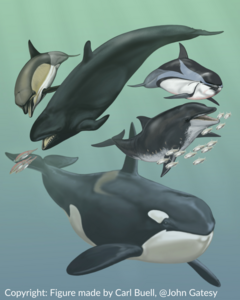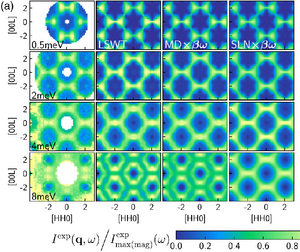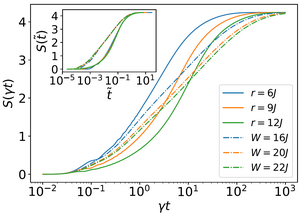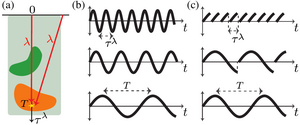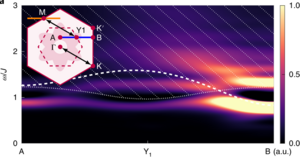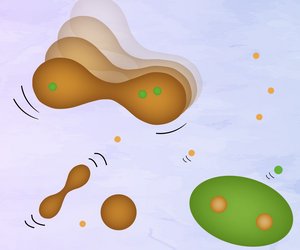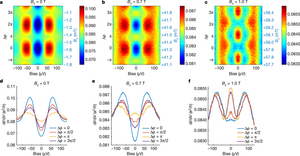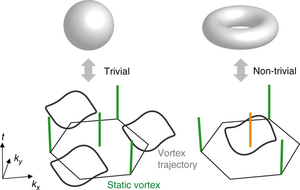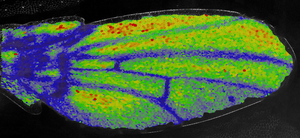Highlights
Publication Highlights
Genes lost during the transition from land to water in cetaceans highlight genomic changes associated with aquatic adaptations
While whales and dolphins spend their entire life in the ocean, these air-breathing mammals actually evolved from terrestrial species. The transition from land to water in the ancestors of modern whales and dolphins about 50 million years ago was accompanied by profound anatomical, physiological, and behavioral adaptations that facilitated life in water. However, which changes in the DNA underlie these adaptations remains incompletely understood. To reveal them, researchers at the Max Planck Institute of Molecular Cell Biology and Genetics (MPI-CBG), the MPI for the Physics of Complex Systems (MPI-PKS), and the Center for Systems Biology Dresden (CSBD) systematically searched for genes that were lost in the ancestor of today’s whales and dolphins. The research team discovered 85 gene losses, some of which likely helped whales to thrive in their new habitat.
M. Huelsmann et al., Science Advances 5, eaaw6671 (2019)
weiterlesenM. Huelsmann et al., Science Advances 5, eaaw6671 (2019)
Publication Highlights
Dynamical Structure Factor of the Three-Dimensional Quantum Spin Liquid Candidate NaCaNi$_2$F$_7$
We study the dynamical structure factor of the spin-1 pyrochlore material NaCaNi$_2$F$_7$, which is well described by a weakly perturbed nearest-neighbour Heisenberg Hamiltonian, Our three approaches—molecular dynamics simulations, stochastic dynamical theory, and linear spin wave theory—reproduce remarkably well the momentum dependence of the experimental inelastic neutron scattering intensity as well as its energy dependence with the exception of the lowest energies. We discuss two surprising aspects and their implications for quantum spin liquids in general: the complete lack of sharp quasiparticle excitations in momentum space and the success of the linear spin wave theory in a regime where it would be expected to fail for several reasons.
S. Zhang et al., Phys. Rev. Lett. 122, 167203 (2019)
weiterlesenS. Zhang et al., Phys. Rev. Lett. 122, 167203 (2019)
Publication Highlights
Bath-Induced Decay of Stark Many-Body Localization
Recently, Stark-localized systems of interacting fermions in tilted lattices were predicted to show signatures of many-body localization similar to Anderson-localized interacting fermions in disorder potentials. Investigating the decay of such Stark many-body localization induced by the coupling to a dephasing bath (as it can be engineered for ultracold atoms in optical lattices), we find qualitative differences in comparison to disordered systems. For instance, the bath-induced growth of the total von Neumann entropy is not found to be logarithmically slow. Our results can directly be tested in systems of ultracold atoms in optical lattices.
L. Wu et al., Phys. Rev. Lett. 123, 030602 (2019)
weiterlesenL. Wu et al., Phys. Rev. Lett. 123, 030602 (2019)
Publication Highlights
How to Directly Measure Floquet Topological Invariants in Optical Lattices
The classification of topological Floquet systems with time-periodic
Hamiltonians transcends that of static systems. For example, spinless
fermions in periodically driven two-dimensional lattices are not
completely characterized by the Chern numbers of the quasienergy bands,
but rather by a set of winding numbers associated with the gaps. We
propose a feasible scheme for measuring these winding numbers in a
periodically driven optical lattice efficiently and directly. It is
based on measuring the topological charges of band-touching
singularities while adiabatically connecting the system of interest to
the topologically trivial high-frequency limit. As a by-product, we also
propose a method for probing spectral properties of time evolution
operators via a time analog of crystallography.
F. Nur Ünal et al., Phys. Rev. Lett. 122, 253601 (2019)
weiterlesenF. Nur Ünal et al., Phys. Rev. Lett. 122, 253601 (2019)
Publication Highlights
Avoided quasiparticle decay from strong quantum interactions
Quantum states of matter—such as solids, magnets and topological phases—typically exhibit collective excitations (for example, phonons, magnons and anyons). These involve the motion of many particles in the system, yet, remarkably, act like a single emergent entity—a quasiparticle. Known to be long lived at the lowest energies, quasiparticles are expected to become unstable when encountering the inevitable continuum of many-particle excited states at high energies, where decay is kinematically allowed. Although this is correct for weak interactions, we show that strong interactions generically stabilize quasiparticles by pushing them out of the continuum. This general mechanism is straightforwardly illustrated in an exactly solvable model. Using state-of-the-art numerics, we find it at work in the spin-1/2 triangular-lattice Heisenberg antiferromagnet (TLHAF). This is surprising given the expectation of magnon decay in this paradigmatic frustrated magnet. Turning to existing experimental data, we identify the detailed phenomenology of avoided decay in the TLHAF material Ba3CoSb2O9, and even in liquid helium, one of the earliest instances of quasiparticle decay. Our work unifies various phenomena above the universal low-energy regime in a comprehensive description. This broadens our window of understanding of many-body excitations, and provides a new perspective for controlling and stabilizing quantum matter in the strongly interacting regime.
R. Verresen et al, Nature Physics (2019), DOI: 10.1038/s41567-019-0535-3
weiterlesenR. Verresen et al, Nature Physics (2019), DOI: 10.1038/s41567-019-0535-3
Publication Highlights
Physics of active emulsions
Phase separating systems that are maintained away from thermodynamic equilibrium via molecular processes represent a class of active systems, which we call active emulsions. These systems are driven by external energy input, for example provided by an external fuel reservoir. The external energy input gives rise to novel phenomena that are not present in passive systems. For instance, concentration gradients can spatially organise emulsions and cause novel droplet size distributions. Another example are active droplets that are subject to chemical reactions such that their nucleation and size can be controlled, and they can divide spontaneously. In this review, we discuss the physics of phase separation and emulsions and show how the concepts that govern such phenomena can be extended to capture the physics of active emulsions. This physics is relevant to the spatial organisation of the biochemistry in living cells, for the development of novel applications in chemical engineering and models for the origin of life.
C. A. Weber et al, Rep. Prog. Phys. 82 (2019) 064601
weiterlesenC. A. Weber et al, Rep. Prog. Phys. 82 (2019) 064601
Publication Highlights
Topological superconductivity in a phase-controlled Josephson junction
Topological superconductors can support localized Majorana states at their boundaries. These quasi-particle excitations obey non-Abelian statistics that can be used to encode and manipulate quantum information in a topologically protected manner. Although signatures of Majorana bound states have been observed in one-dimensional systems, there is an ongoing effort to find alternative platforms that do not require fine-tuning of parameters and can be easily scaled to large numbers of states. Here, we present an experimental approach towards a two-dimensional architecture of Majorana bound states. Using a Josephson junction made of a HgTe quantum well coupled to thin-film aluminium, we are able to tune the transition between a trivial and a topological superconducting state by controlling the phase difference across the junction and applying an in-plane magnetic field. We determine the topological state of the resulting superconductor by measuring the tunnelling conductance at the edge of the junction. At low magnetic fields, we observe a minimum in the tunnelling spectra near zero bias, consistent with a trivial superconductor. However, as the magnetic field increases, the tunnelling conductance develops a zero-bias peak, which persists over a range of phase differences that expands systematically with increasing magnetic field. Our observations are consistent with theoretical predictions for this system and with full quantum mechanical numerical simulations performed on model systems with similar dimensions and parameters. Our work establishes this system as a promising platform for realizing topological superconductivity and for creating and manipulating Majorana modes and probing topological superconducting phases in two-dimensional systems.
H. Ren, F. Pientka et al, Nature 569 , 93–98 (2019)
weiterlesenH. Ren, F. Pientka et al, Nature
Publication Highlights
Measuring topology from dynamics by obtaining the Chern number from a linking number
Integer-valued topological indices, characterizing nonlocal properties of quantum states of matter, are known to directly predict robust physical properties of equilibrium systems. The Chern number, e.g., determines the quantized Hall conductivity of an insulator. Using non-interacting fermionic atoms in a periodically driven optical lattice, scientists from the University of Hamburg and the MPIPKS in Dresden have demonstrated experimentally that the Chern number determines also the far-from-equilibrium dynamics of a quantum system. Namely, it dictates the linking number of the trajectories of momentum-space vortices, as they emerge after an abrupt change of system parameters.
M. Tarnowski et al., Nat. Commun. 10, 1728 (2019)
weiterlesenM. Tarnowski et al., Nat. Commun. 10, 1728 (2019)
Publication Highlights
Quantum localization bounds Trotter errors in digital quantum simulation
Quantum computers promise to solve certain computational problems exponentially faster than any classical machine. A particularly promising application is the solution of quantum many-body problems utilizing the concept of digital quantum simulation. A fundamental challenge, however, is the control of an intrinsic error source, which appears due to the utilized time discretization. Here, we show that quantum localization-by constraining the time evolution through quantum interference-strongly bounds these errors for local observables. Digital quantum simulation is thus intrinsically much more robust than expected from known global error bounds.
M. Heyl et al., Science Advances 5, eaau8342 (2019)
weiterlesenM. Heyl et al., Science Advances 5, eaau8342 (2019)
Publication Highlights
How tissues respond to mechanical stress
Underlying mechanism of cell viscoelasticity revealed
Epithelial tissues like our skin are made of cells that are tightly connected through E-Cadherin – a protein that binds adjacent cells together. These tissues respond differently to forces from the environment. When they are subjected to forces for a short duration they behave like an elastic band, whereas, when subjected to the same force for a longer duration they show viscous behavior like honey. This property of tissues, called viscoelasticity, plays a key role to understand tissue shape changes during embryonic development. Although viscoelasticity is a well-known property, the molecular mechanisms underlying such viscoelastic behavior of developing tissues were largely unknown, so far.
weiterlesenEpithelial tissues like our skin are made of cells that are tightly connected through E-Cadherin – a protein that binds adjacent cells together. These tissues respond differently to forces from the environment. When they are subjected to forces for a short duration they behave like an elastic band, whereas, when subjected to the same force for a longer duration they show viscous behavior like honey. This property of tissues, called viscoelasticity, plays a key role to understand tissue shape changes during embryonic development. Although viscoelasticity is a well-known property, the molecular mechanisms underlying such viscoelastic behavior of developing tissues were largely unknown, so far.


